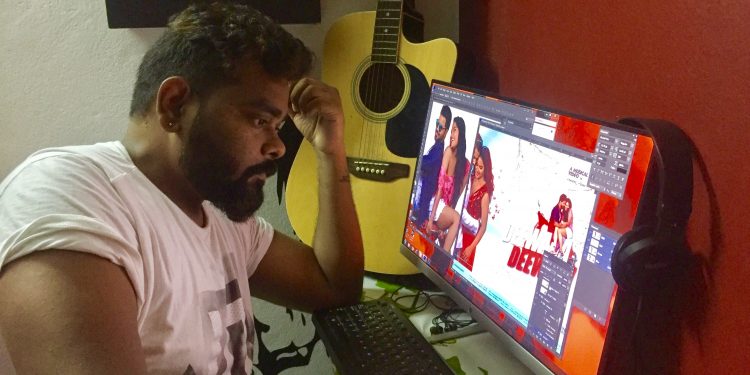The poster of a film or a music album is a vital element to attract audience attention. It may be a Hollywood film or an Odia music album, the people in charge of the project always try to design a captivating poster. Today, technology has provided numerous options for a poster. While a poster is usually associated with a still image, in the last few years, motion posters are creating a buzz. The motion posters trend originated in Hollywood and was adopted later by many film industries including Bollywood. We now see a few instances of this trend in the Odia music industry. Sunday POST, which talked to a few motion poster makers in Odisha, describes the evolution and usage of the technology, internationally and nationally.
A motion poster, or moster, is a high-resolution animation work for a film or music album authorised by the production company. It is not a teaser. Rather, it can be described as a unique work created with the help of latest technology to create a buzz about an upcoming film. As its name suggests, a motion poster is an animation, normally lasting a minute, that concludes with the original poster of the film or music album.
As per reports, GeekNation.com came up with this concept first for the thriller Hard Candy, offering a high-resolution animation of the original film poster. The motion poster, commissioned by the studio Lionsgate, was released on GeekNation.com. Designed to nudge moviegoers into watching the film, it featured Ellen Page’s character Hayley Stark bouncing on a trap and was created by Happy Trails Animation’s Andy Collen.
Motion posters are usually created with a resolution of 640 x 426 pixels. However, in some cases, a moster can be of a higher resolution up to 1920 x 1280. Generally, mosters should partly or fully use elements of the original movie poster. It cannot use live action from the movie. Finally, the animation must end with the still image of the original poster.
Motion posters were used for the Hollywood film Star Trek that featured Chris Pine as Captain Kirk. Later, motion posters were made for films like Jaws, Planet Terror, Hanna, Saw IV and Angels & Demons. Other Hollywood movies that used motion posters as part of their marketing campaigns include Now You See Me and The Wolverine. TV series American Horror Story also used motion posters for its publicity campaign.
Soon the Hindi film industry also picked up the moster trend. Motion posters were made for popular films like PK, Singham Returns, Holiday, and Queen. In the motion poster for the Aamir Khan starrer PK, Aamir’s look was revealed after first giving a sandstorm kind of feel; his voiceover then asked the viewers what they were staring at and if they recognised him as PK. For the movie Queen, the moster featured Kangana in a Bollywood dance pose (the one that she strikes often in the movie) while the evergreen track Hungama ho gaya played in the background. The poster ends with Kangana’s voiceover saying, ‘Jai Mata Di.’ For the movie Holiday, the creative team made a visual introduction of Akshay Kumar’s character’s name, which was followed by flashing of the date when the first look would be revealed. In the action-packed moster of Singham Returns,’ director Rohit Shetty manages to attract the viewer’s attention by providing a great first look of Ajay Devgn; in the background Singham’s theme music adds to the overall feel.
In the Odisha context, the credit for introducing a motion poster goes to music album Deewana Deewani. Vighnanz – The Band released the first ever motion poster as the first look of the music video that features Subhasis Sharma and Anisha Sharma.
The moster of Deewana Deeewani was conceptualised and designed by Being Creative’s Surya. He said, “The poster is based on the concept of love and romance. We have played with some subjects from the song, a red scooter being the dominant one. Besides, the sizzling chemistry of the lead couple has also been captured.”
G Durga Prasad, singer of the solo, said, “We always wish to deliver something new to our audience and, so far, no one had explored motion poster technology in Odisha.”
“Through this initiative, we want to be more competitive. It’s time that we start experimenting and breaking stereotypes. The music industry of our neighbouring states has been delivering output at par with the national level, but sadly we are much behind. Hence, through our work, we wish to represent Odisha as a quality conscious state,” he added.
HIMANSHU GURU, OP






































